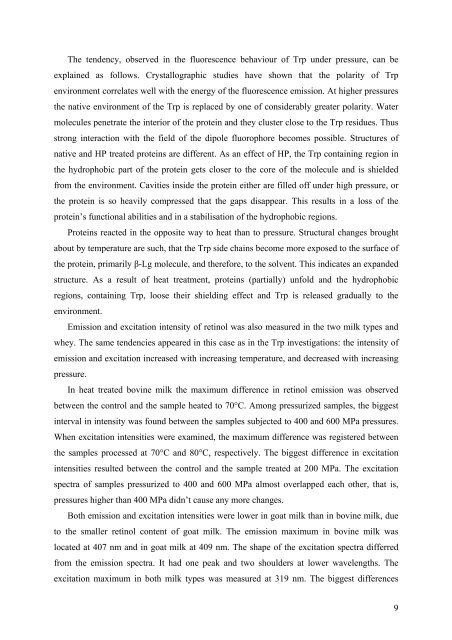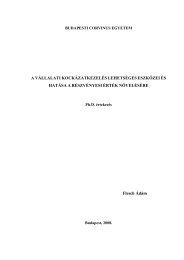Klára Pásztor-Huszár - Budapesti Corvinus Egyetem
Klára Pásztor-Huszár - Budapesti Corvinus Egyetem
Klára Pásztor-Huszár - Budapesti Corvinus Egyetem
Create successful ePaper yourself
Turn your PDF publications into a flip-book with our unique Google optimized e-Paper software.
The tendency, observed in the fluorescence behaviour of Trp under pressure, can be<br />
explained as follows. Crystallographic studies have shown that the polarity of Trp<br />
environment correlates well with the energy of the fluorescence emission. At higher pressures<br />
the native environment of the Trp is replaced by one of considerably greater polarity. Water<br />
molecules penetrate the interior of the protein and they cluster close to the Trp residues. Thus<br />
strong interaction with the field of the dipole fluorophore becomes possible. Structures of<br />
native and HP treated proteins are different. As an effect of HP, the Trp containing region in<br />
the hydrophobic part of the protein gets closer to the core of the molecule and is shielded<br />
from the environment. Cavities inside the protein either are filled off under high pressure, or<br />
the protein is so heavily compressed that the gaps disappear. This results in a loss of the<br />
protein’s functional abilities and in a stabilisation of the hydrophobic regions.<br />
Proteins reacted in the opposite way to heat than to pressure. Structural changes brought<br />
about by temperature are such, that the Trp side chains become more exposed to the surface of<br />
the protein, primarily β-Lg molecule, and therefore, to the solvent. This indicates an expanded<br />
structure. As a result of heat treatment, proteins (partially) unfold and the hydrophobic<br />
regions, containing Trp, loose their shielding effect and Trp is released gradually to the<br />
environment.<br />
Emission and excitation intensity of retinol was also measured in the two milk types and<br />
whey. The same tendencies appeared in this case as in the Trp investigations: the intensity of<br />
emission and excitation increased with increasing temperature, and decreased with increasing<br />
pressure.<br />
In heat treated bovine milk the maximum difference in retinol emission was observed<br />
between the control and the sample heated to 70°C. Among pressurized samples, the biggest<br />
interval in intensity was found between the samples subjected to 400 and 600 MPa pressures.<br />
When excitation intensities were examined, the maximum difference was registered between<br />
the samples processed at 70°C and 80°C, respectively. The biggest difference in excitation<br />
intensities resulted between the control and the sample treated at 200 MPa. The excitation<br />
spectra of samples pressurized to 400 and 600 MPa almost overlapped each other, that is,<br />
pressures higher than 400 MPa didn’t cause any more changes.<br />
Both emission and excitation intensities were lower in goat milk than in bovine milk, due<br />
to the smaller retinol content of goat milk. The emission maximum in bovine milk was<br />
located at 407 nm and in goat milk at 409 nm. The shape of the excitation spectra differred<br />
from the emission spectra. It had one peak and two shoulders at lower wavelengths. The<br />
excitation maximum in both milk types was measured at 319 nm. The biggest differences<br />
9
















